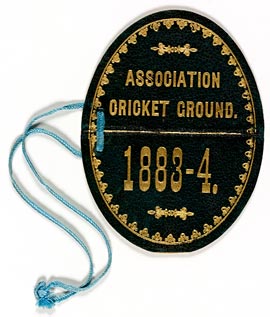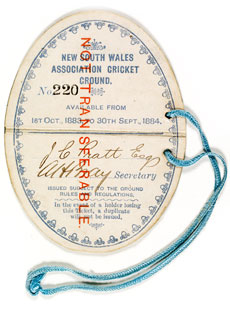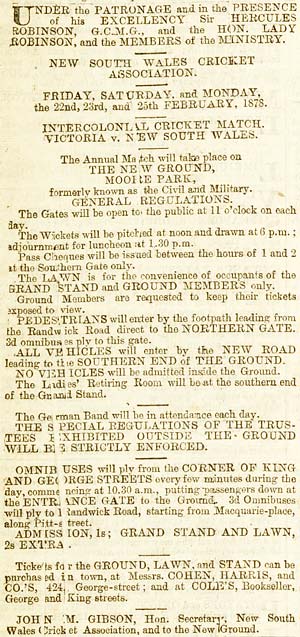Sydney Cricket Ground: the home of cricket in Sydney
The foundations for the Sydney Cricket Ground (SCG) were laid in the 1850s by British soldiers on land south of Victoria Barracks and known as the Military and Civil Ground.
During the 1860s the ground was mainly used as practice grounds or for minor club fixtures. Hyde Park, the Outer Domain and the Albert Ground in Redfern were also being used for cricket but this changed in 1868 with the development of Moore Park.
After British troops departed in the 1870s, control of the ground passed through several hands before it was taken over by the NSW Cricket Association in 1875.
In 1877 it was renamed the Association Ground and on the 25th of October the first match was played on the new ground. The Civil Service Challenge Cup played between the Government Printing Office and the Audit Office featured a number of players who would be important in the history of the SCG and cricket in Australia including Alick Bannerman and Dave Gregory.


New South Wales Association Cricket Ground - membership ticket, 1883-1884, 1st Oct. 1883 - 30 Sept, 1884
Ephemera. R 963
Membership to the Association Ground cost two guineas and each member was entitled to two ladies passes at no extra charge – this was reported in the press at the time as being exploited with numerous ladies entering on the one ticket. After entering one of the two ladies would then go back outside and hand the pass to another one waiting outside.
The official inauguration match for the ground was played in February 1878 between Victoria and New South Wales. There was a 1 shilling admission charge; 1 shilling extra for the Grand Stand and Lawn. The opening of the new ground was not without trouble as there was much opposition to the charging of admission fees. In the days prior to the match posters and handbills had been circulated in Sydney attacking the Cricket Association for this. It is not known who circulated these but it has been supposed that the Albert Cricket Ground Company, faced with loss of business, may have been behind it. Hoping to ward off any troublemakers the NSW Cricket Association published the following warning in Sydney newspapers on the opening day of the match – ‘any person behaving in a threatening or disorderly manner at the gate will not be admitted to the Ground’.

Sydney morning herald, February 22 1878, page 2. Sydney : Charles Kemp and John Fairfax, 1842
Broadsheet in bound volume. BN 445
In 1878 the only sizeable buildings at the ground were the Brewongle stand, also called the Grand Stand, a wooden pavilion and a number of small refreshment stands. By the late 1890s major changes occurred at the ground including its renaming in 1894 to the Sydney Cricket Ground.
> View images showing how the face of the Sydney Cricket Ground has changed over time
Not everything built at the ground was viewed with favour and the cycle track, which was removed in 1920, was one. The track was unpopular with the cricketers who felt that it detracted from the SCG’s identity as a cricket ground. A beloved feature was the scoreboard and the 'Robertson and Marks' version can be seen clearly in this image from 15th December 1928 of the Second Test Match between Australia and England. This game provided the record attendance for a cricket game at the SCG, a record of 58,446 that still stands today.
2nd Test Match SCG (15.12.1928), 1928, E.B Studios
Photograph XVIA MOO P/1
Part of the magic of the SCG has always been the crowds. From its earliest days it has played an important part in Sydney’s entertainment, a place to be seen and a place for enjoyment. It has not always been a peaceful place as history records that there was trouble even back in 1879. A riot occurred in 1879 during a match between NSW and touring Englishmen with spectators swarming on to the pitch a number of times during the game. The game was eventually called off for the day. One of the umpires from this eventful game was Edmund Barton, who later became Australia’s first Prime Minister.
> View images of spectators at the Sydney Cricket Ground
